#specially urobuchi. when he's around everyone loses.
Explore tagged Tumblr posts
Text
So, the trailer for Walpurgis no Kaiten has dropped, and like always, I am confused and struggling to give a fuck about it.
Do I get bonus point if I act like I care for something that hasn't been touched on for 10 years, has most likely aged like milk, and will have everyone in the cast still suffering?
#magical girl#it's coming out on winter next year if anyone even cares.#i am curious to what's going on; but given the team that worked on this project i don't have high hopes for it.#don't expect me to have expectations when magia quartet is involved.#specially urobuchi. when he's around everyone loses.
3 notes
·
View notes
Text
BLOODHOUND.masterpost (WIP)

A terrorist attack has left Britain in the midst of a zombie pandemic. The ‘Disease’ turns humans into monsters - mutants beyond recognition, turning cities to dust and drawing innocents into their evergrowing hivemind.
Enter the Bloodhounds; a superhuman spec-ops unit, and one of the country’s last hopes.
When one of their members loses their memory during an arson attack, the Bloodhounds are determined to locate the group responsible. During their investigation, however, they learn of a much darker terrorist plot that could not only destroy them, but what little remains of society.
~
Tldr; I've been writing a book for 10+ years and I'm finally posting it!
If you like action, body h0rror, and B-Movie cheese, please consider giving it a read.
Trigger warning for violence and gore.
Currently available on Wattpad!
What is BLOODHOUND?
Bloodhound (stylised as BLOODHOUND.) is a post-apocalyptic sci-fi project. It revolves around a group of superhuman soldiers - the titular Bloodhounds - fighting a biomechanical plague and the terrorist group that spread it. The project has been in the works since late 2013, and is primarily a novel series.
The lore of the Bloodhound universe is inspired by the works of Digital Extremes, Gen Urobuchi and Hideo Kojima.
The book is currently unfinished, but I don't know if I'm ever going to finish it, so I'm putting the current draft up for everyone to enjoy (ironically and unironically). Any feedback is appreciated, as I have a lot of passion projects in my backlog that I'd love to share with the world as well.
The Story
The year is 2048. A terrorist organisation has infected the world with a biomechanical virus, known simply as the Disease. Victims are dragged into a hivemind, skin hardening like steel, their bodies twisted and warped beyond recognition. These Diseased have only one goal; to continue its spread.
Scientists around the world began to collaborate, in search of a cure. Britain - the first target of the Disease - managed to reverse-engineer the virus while trying to create a vaccine. The nanites in this ‘Anti-Disease’ not only acted as immunity against its counterpart, but granted superhuman abilities and protected hosts from injury by hardening the skin, without permanent damage.
And so, the Ministry of Defense came up with a unique proposal for defending its citizens. They transformed this early vaccine into a Psionic system that grants powerful abilities, through a neurolink that connects to complex military technology. The result was the Bloodhounds - a special operations unit dedicated to fighting the most powerful Diseased thralls and saving what remains of humanity.
One day, however, one of its members is lured away by the same terrorist group that started the pandemic. He awakens with no memory of his past life, only to discover he’s been infected, the virus having slipped through his Psionic’s defence system. The group bands together to get their revenge, only to discover that their enemy is planning something far greater - something that could wipe out all of them.
Characters
The protagonist designs were initially inspired by AT's Secret Weapon line of theme park rides, and later on took inspiration from gods from greek mythology. Originally conceived in 2010, the cast was repurposed with their own lore, setting and story.
Unfortunately, I don't have character refs for all of them at this time, but here's the best I've got of the main four: Jesse, Andrew, Chloe and Zora.




There are other characters with the same design principles, but I won't be including them in the post until later updates.
The villain of the story - an entity known as Lynx - doesn't follow the same design trend as the other characters. Instead, they're based on biomechanical entities such as the technocyte plague from DarkSector and the WAU from Soma.

(TBC)
#master post#neme ocs#bloodhound.neme#writers on tumblr#novel#first book#wattpad#authors on tumblr#first novel#scifi#superhero
4 notes
·
View notes
Text
anime featuring adult women
there are a lot of great female characters in anime, but sometimes it feels like they’re all supporting characters in shows about men or they haven’t graduated high school yet. I wanted to compile a list of some anime with adult women front and center
kidou keisatsu patlabor on tv:
in the sci-fi future as imagined in 1988, human-piloted robots called labors are used regularly by all kinds of people, including criminals. to combat labor crime, the police develop a special unit of patrol labors—patlabor. instead of following the prestigious division one, we follow a cast of quirky characters in second-string division two, as they solve cases ranging from mundane to dangerous to paranormal
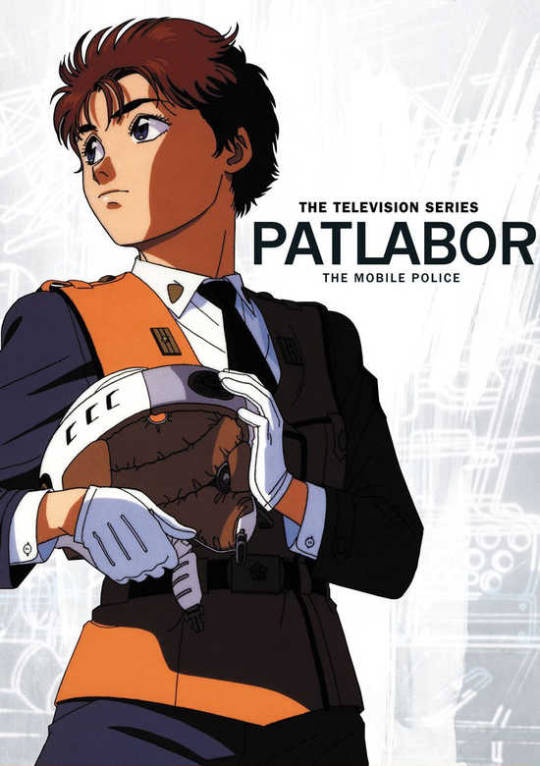
izumi noa, and why I love her:
she’s incredibly strong-willed and stubborn. she’ll stand up to anyone. she’s obsessed with labors, not just piloting them herself but repairing them and learning about new developments in the field. even though division two is primarily men and there is the “men at work” vibe of so much military and police fiction, noa fits in easily with the guys and no one excludes her. the few times people do question her skills bc of her gender, they’re immediately shut down
other women in the cast:
nagumo shinobu, the captain of division one. we never actually see her or her unit at work, but they have a great reputation. I just love her bc she’s very funny always shutting down the captain of division two and I like that in-universe there are women in leadership roles like this
kanuka clancy, a visiting cop from new york. her relationship with noa is very strong, definitely shippable. she’s adept with a gun, a sword, and a giant robot. she’s the serious member of the team who yells at the others for being dumb but there are still times where she goes completely off the rails and ignores the law to do what she knows is right
wotakoi: love is hard for otaku:
momose narumi is an office worker and a fujoshi. she wants to keep the fujoshi part a secret this time around because things went south for her at her last job once people found out she was an otaku, but it turns out several of her new coworkers are fellow nerds. most importantly, her game-loving childhood friend hirotaka works at the same company, and the two of them reconnect as friends… and soon more than friends. it’s a romance drama involving only nerds
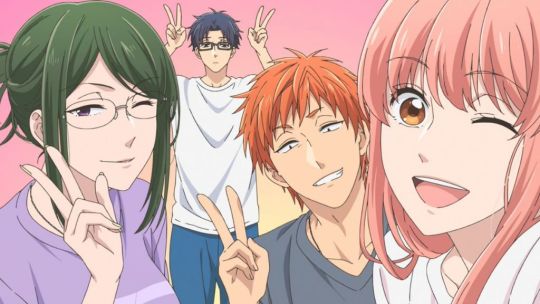
momose narumi, and why I love her:
she’s a lot like your standard high school girl protagonist who runs out of the house because she’s late for school, but this time she’s late for work. she’s really funny and straightforward, except she thinks she has to hide that side of her at her job. she and hirotaka have a great childhood friends to lovers relationship. she’s kind of rude to him but he adores her (though he’s kind of bad at showing it). I love a cheerful girl/serious guy romance that’s done well and I think this one really is
other women in the cast:
koyanagi hanako, narumi’s new coworker who’s a fellow fujoshi. she’s also a cosplayer, specifically a crossplayer who specializes in cosplaying as handsome guys. she and narumi only met each other under their fandom nicknames before, but they were big fans of each other and hit it off instantly when they meet at work. they’re cute friends even if they always argue about who tops in their ships
psycho-pass:
in a futuristic society, people’s mental health is constantly measured by “psycho-pass” readings which track their emotional state and judge the likelihood that they will commit a crime. naive rookie cop tsunemori akane leads a team of enforcers, people who are considered “latent criminals” too dangerous to live in normal society but who are still useful to the police. akane develops a close relationship with enforcer kougami shinya in particular, but kougami has his own intense relationship with the elusive criminal makishima shogo. as the team of detectives investigate him, they uncover secrets about the system they never wanted to learn and their fates become entwined with makishima’s
psycho-pass is written by urobuchi gen (madoka magica, fate/zero) and if you’re familiar with him you know what to expect. the show is pretty grim and gory. content warnings for rape, violence, gore, body horror, police violence, the predatory lesbian trope, forced institutionalization, and probably a lot of other things I can’t remember. not a light watch, is what I’m saying

tsunemori akane, and why I love her:
she’s incredibly principled. she sticks to what she believes is right despite immense pressure. it’s precisely because she’s naive and doesn’t understand the system that she is able to fight against it. she grows a huge amount over the course of the series but she never loses her compassion or her sense of right and wrong. she’s pretty badass too
other women in the cast:
karanomori shion, a lab analyst at the public safety bureau. she’s your typical sexy and flirtatious anime character but I think her position within the setting is interesting. although she’s categorized as a “latent criminal” unfit for society, she seems to be valued more than the enforcers. she’s also bisexual and dating a woman, though she plays into the “bisexuals can’t settle down” trope a little. she is not actually the best character or peak representation but I’m pretty attached to her and a certain type of woman will be too
kunizuka yayoi, a lesbian former musician and the only female enforcer. she’s shion’s girlfriend. there is a predatory lesbian character in this series, but it’s not kunizuka. I think her being a lesbian is handled pretty well. she has romantic and sexual relationships with women that are important to her, but she doesn’t hate men or flirt with every woman she meets (traits I hate to see in lesbian characters written by men). she’s really serious and calm but still cute and I love to see her growing respect for akane over the course of the show
death parade:
two people wake up in a strange bar with no memory of how they got there. a mysterious man with white hair named decim and his assistant, a woman known only as “the black haired woman,” ask them to play a game. the games are both absurd and dangerous, and as the contestants play them dark sides of themselves are revealed. decim’s job is to judge them based on their behavior while playing the games, but the black haired woman’s influence causes him to wonder if he’s doing the right thing
like it says in the title, the anime deals with the topic of death, and death by suicide comes up as well. I don’t remember everyone’s backstories but I think violence and abuse come up several times. there are also mannequins that move around on marionette strings which is kind of freaky
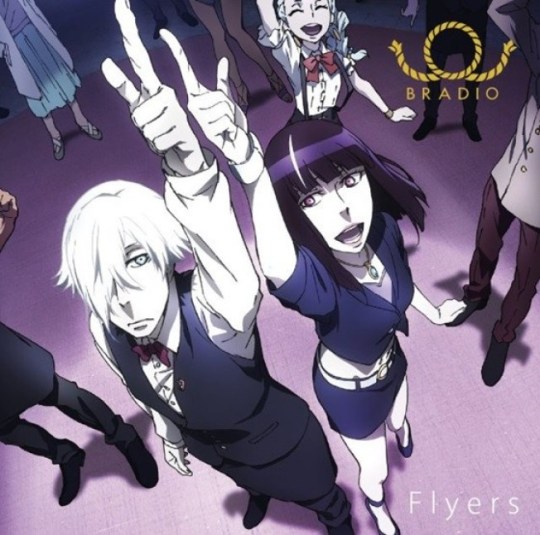
the black haired woman, and why I love her:
it might be wrong to say that she’s the main character when she isn’t introduced until the end of the first episode and her name isn’t revealed for half the show but listen. she’s the emotional core of the show and the person who sets the events in motion. she’s a very emotional person and that’s her strength. her relationship with decim is the classic “woman teaches cold-hearted man to feel” trope but I think it’s an outstanding example bc it centers her emotional experience and the two of them are not explicitly in a romantic relationship. I’ve been trying to avoid spoilers but for her it’s almost unavoidable. I love the way that her story is slowly revealed over the course of the show culminating in an incredible sequence in episode 11. I think her depression is handled so well too. it’s heartbreaking
other women in the cast:
nona, the boss of the arbiters. she’s a schemer who knows a whole lot of things she’s keeping from everyone else. I really like her outfit above all else. baggy pants with suspenders… a great look
mayu, a high school girl who is a contestant in one of the games. she tries to be cutesy but is prone to anger and makes incredible faces. I like that she’s an obsessive fangirl character who’s played for humor but is also shown as being noble and sympathetic
sakura quest:
koharu yoshino is a woman who moved to tokyo to find a job but has no luck. when she finally gets a job offer, it’s to become “queen for a day” of rural manoyama village. upon arriving in manoyama, she learns that she was only hired because they thought she was someone else but they still want her to work there for an entire year. now she lives in a small town and is tasked with both revitalizing the citizens and drawing tourists in, along with the help of four friends. it may not sound funny and heartwarming but it really is. it’s a good story about connecting and reconnecting and also the head of the tourism board wears a chupacabra mask sometimes

the main characters, and why I love them:
koharu yoshino, queen of manoyama. her struggle in the job market is unfortunately relatable to many people today and I love that she wishes she could have a job as a queen. she’s great and she really comes to love the town despite everything
shiori shinomiya, a very sweet manoyama native. she’s almost too nice but it makes it all the funnier when she gets intense
maki midorikawa, an aspiring actor who is famous among manoyama citizens for a small role she played in the past. she’s serious about acting but her family wishes she would get a more stable job. she can be kind of rude but she does love her friends and her town
sanae kouzuki, a web developer who moved to manoyama to escape the intensity of city life and the negative effects it had on her mental health. the problem is she hates rural life and is afraid of bugs but is too proud to admit it on her blog. the only true city girl among the five
ririko oribe, my favorite of the five. she’s shy but loves cryptids and the occult. it’s very easy to read her as autistic and the other characters affirm her interests and behavior. her love of cryptids even helps the town out when Spanish tourists come in search of a local legend. her relationship with her grandma is really good as well, with the two coming to understand and love each other over the course of the show
362 notes
·
View notes
Text
Short Reflection: Madoka Magica Rebellion
In my eyes, Madoka Magica is a story about balance. Every wish is mirrored by an equivalent curse, but all despair must similarly stand against hope. The world isn’t perfect, but it isn’t doomed either, and the only way forward is to acknowledge those ambiguities as you strive to keep that balance both within yourself and the world around you. And the show itself was similarly balanced, sliding slowly into the darkness at its core and rending apart with despair without ever losing sight of the hope that made its world and characters worth fighting for. There’s a reason that Gen Urobuchi’s stories remain so beloved despite the pain he puts us through; as dark as he gets, he never forgets to keep the lights on as well. And I would have been perfectly satisfied if the story had ended with the show, if the twelve TV episodes of Madoka Magica had been all the Madoka Magica we ever got. It accomplished everything I wanted it to and kept that balance wonderfully all the way. So when I went into the sequel film Rebellion, even though I was aware of the big infamous ending twist (which I won’t spoil here for your sake, so don’t worry), I genuinely wasn’t sure what to expect. And now that I’ve come out of it... I might be even less sure than before.
Yeah, my thoughts on Rebellion are kind of all over the place, and I’m still trying to piece them together even as I’m writing them up. But the one thing I am certain of is that this movie is lacking that critical component that made Madoka so special to me. In other words, it lacks balance. And with that guiding principle gone, it’s no surprise this film ended up as divisive as it did. This film is a fucking mess, sometimes in good ways, sometimes in frustrating ways, sometimes in ways that leave you unsure how to take it. I can’t say I hated it, or even disliked it; in fact, I’m pretty sure it’s overall a success. But if Madoka Magica was a perfect 2K sprint over the finish line, then Rebellion crosses the finish line stumbling over its own two feet and keeling from side to side every other second. It’s surprising and evocative and keeps you on your toes, but it also leaves you concerned and confused, caught between cheering it on and wanting someone to head over and make sure it’s doing okay. I give it credit for its audacity, if nothing else, but compared to how expertly the show proper was able to grip my head and heart, I can’t deny that I came out of Rebellion feeling kind of hollow. And that’s one emotion Urobuchi has never left me with before.
Perhaps a brief plot summary will help put my thoughts in focus. Following the TV show’s ending, Rebellion immediately lets you know something foul’s afoot by establishing a status quo that’s nothing like the one we were left with. All five girls are still alive, Homura is once again her pre-angst pigtail self, they’re all happilly fighting as magical girls, and their enemies are Nightmares instead of Witches or Wraiths. Also, Kyubey suddenly can’t talk and the witch who killed Mami is suddenly acting as her familiar. The message is clear: despite how idyllic it all looks, something is very wrong. I won’t spoil what’s really going on, but suffice to say, the plot involves Homura slowly waking up to the true nature of the mysterious situation and piecing together how we got from the end of the show to here. No points for guessing that the answers are all tragic, the vice is tightened on everyone like never before, and a huge swath of the drama revolves around Homura’s unresolved feelings about Madoka leaving her to become a god and watch over humanity. Make no mistake, this film is entirely Homura’s story, with the rest of the girls mostly static side characters who exist for her to bounce off of. More specifically, it’s the story of the choices Homura made, the choices she has yet to make, and the decision she ultimately reaches in regards to her and Madoka’s place in the universe.
It’s really fascinating what all these answers end up being, and I can’t say any of them were unjustified. Madoka has always been willing to let its characters make imperfect, even painful choices, and Rebellion lets Homura lean on that tension for all it’s worth. But that’s also all these choices did: fascinate me. Whereas in the show proper, when the characters screwed up or fell on their own swords, I was gripped from the depths of my soul. Rebellion’s problem isn’t that it’s needlessly bleak, or goes in bad directions, or fundamentally ruins any character. The problem is that it fails to justify its harsh turns with the same emotional balance as the show. It fails to capture the delicate dance of light and dark that made Madoka so powerful to me; instead, it’s a film of nothing but extremes. Extreme happiness and extreme sorrow, extreme kindness and extreme fury. Rebellion doesn’t weave these complex, human strands of feeling together in the same way the show does; it just lets them explode out and hit you without giving much thought to how they work together. And ironically enough, that just makes them have all the less impact.
The best way I can describe this is by saying that Rebellion essentially has two modes; extreme excessive fluffy Madoka fanservice or extreme gut-wrenching inescapable despair. The first third, while the “fake” world is active and stable, is essentially a chance to give the audience a taste of what a “traditional” magical version of Madoka would be like, where the characters are all living relatively normal lives and are all one big happy family (hence why Kyubey’s demoted to a monosyllabic mascot character as well). But Madoka to me just isn’t interesting as a normal magical girl show. It needs the darkness of its plot to give its characters and their struggles meaning, and without that darkness, frankly, none of the girls remain that interesting. I’m still not the biggest fan of the early episodes of the show before the darker elements start creeping in, and this movie only reinforces that sentiment. Later, as Homura figures out what’s really going on, the emotional journey she undergoes is almost infernal in its level of despair and helplessness. But it doesn’t land nearly as hard as it should without the gradual descent into the pits of darkness that the show managed so spectacularly. Then we get a massive final battle that’s yet more fanservice without a scrap of that previous pain, and when that final nasty twist comes, it hits right at the apex of the franchise’s most unapologetically sappy and sentimental stretch yet. It’s whiplash upon whiplash, either all easy answers or no answers at all, and neither of those extremes works nearly as well as both of them together. I say again, Madoka Magica just doesn’t work without balance, and by giving into excess, Rebellion proves how important that balance truly was.
It’s a good thing, then, that at least some of that excess remains entertaining in its own right. Despite my relative disinterest in a “normal” magical girl version of this show, I can’t deny it was great to see all five girls finally together in the same place and bouncing off each other. Kyoko and Sayaka especially are gangbusters together, and turning their bitter grudge into a friendly rivalry left a real damn big smile on my face. But it’s the visuals that really carry the weight here, because good fucking god, this movie is an animation feast. The show was already beautiful enough, but now that they’ve got a film budget to swing around, Shaft is able to blow the whole thing up into a kaleidoscopic supernova. The character animation is seamless, every frame is packed with a million moving pieces, the world feels more fleshed out and detailed than ever before, the imagery is so mind-bogglingly surreal you’d swear you were on acid, the action is somehow even more gobsmacking than the show, and all of it is animated with a gorgeous, almost pornographic level of polish that makes you feel like you’re swimming in an ocean of Salvadore Dali’s most vibrant daydreams and nightmares. There’s a fight between Mami and Homura near the movie’s midpoint that utilizes Homura’s time-freezing powers to stop and start absurdly massive volleys of gunshots, and the level of detail in the chaos left my jaw on the goddamn floor. That might genuinely be the best fight scene in the entire franchise; I’m still kind of reeling from it.
So on the whole, I can’t call Rebellion a failure. It’s big and messy and it goes in a million different directions, but there’s no denying it sets off some truly astounding fireworks in the process. Still, the more I think about it, the more crushed I become that it wasn’t better. To me, Madoka Magica’s final episode was the end of the story, and this big unwieldy sequel is just a intriguing “what if” to consider. Maybe the next movie in the series will finally come out at some point and bring this roller coaster to a fulfilling stop. But until then, Rebellion remains a fascinating, flawed, ambitious, and achingly unsatisfying reminder of just how important balance was to this show’s success. And I give it a score of:
6/10
And that, I think, is the official end of my Madoka re-watch. We’ve got Magia Record coming out in just a few days, and I’m certain I’ll have thoughts on that to share as I go through it. Until then, though, thank you for joining me on this trip down memory lane, and I’ll see you all for whatever comes next!
#anime#the anime binge-watcher#tabw#madoka magica#madoka rw#puella magi madoka magica#mahou shoujo madoka magica#madoka magica rebellion#madoka kaname#sayaka miki#mami tomoe#kyoko sakura#homura akemi
16 notes
·
View notes
Text
Anime Ramble: Puella Magi Madoka Magica
Magical Girl anime have this tendency to provoke a binary reaction. Either you see Magical Girls on the promo material and want to watch the show, or else you don’t. So, I’d like to preface this bout of gushing-about-a-show-that-I-watched by saying that your initial reaction to seeing the below poster should be discarded and you should just watch this show.
No, really, I think it’s safe to say that if you have an initial gut reaction of “I’m not interested” then you are probably going to appreciate this show quite a bit, while those who are avid fans of the Magical Girl genre might actually end up being put off by their expectations. Not because of what this show is, but rather by what this show isn’t.
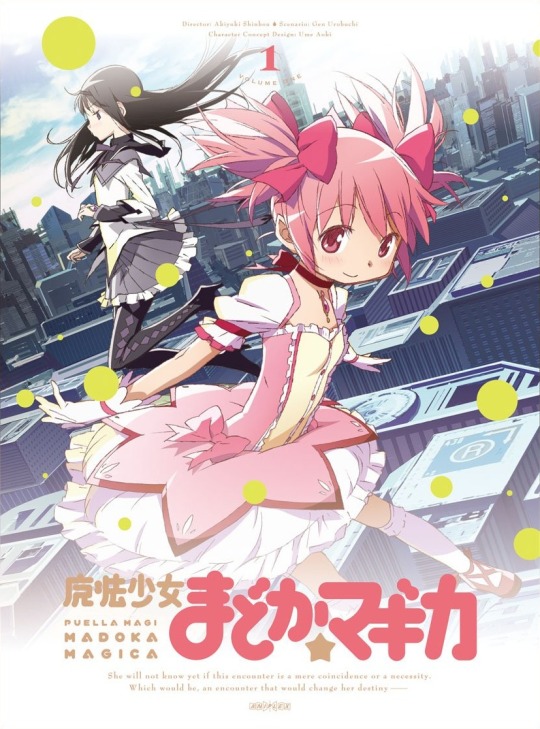
In the same way that everyone knows that Darth Vader is Luke’s father or that a certain noble from the North loses their head, there are some story twists which percolate into the general cultural consciousness due to sheer popularity and end up becoming common knowledge. Puella Magi Madoka Magica is a series which blew up to such popularity in 2011 that you’ve probably seen the characters somewhere before even if you don’t watch a lot of anime. You’ve probably also seen this little guy
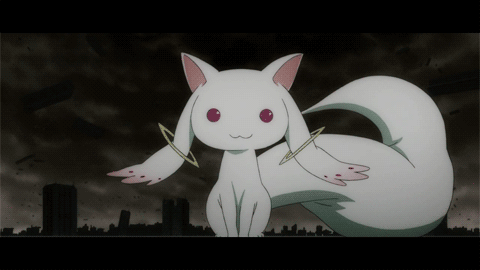
around, often in the context of memes in which either 1) he tries to get people to make a contract or 2) people inflict violence on him and his smug little face never changes.
So while I want to say that Madoka Magica will surprise you when it pulls a left turn into darkness and despair, not only have I just ruined that specific surprise for you but the internet at large more than likely already did that job for me. Not only was this show popular, which translates into a more widespread awareness of its overall tone and some of its twists, other more recent shows have pulled a similar deception. Only last year did we have Made in Abyss, which I haven’t seen yet but which I understand exists for the sole purpose of having cute kids set off on an exciting adventure only to be eaten alive by Uncle Lovecraft’s Happy Fun Time Cave. If you’ve been around the anime niches of the internet or, like me, have a former otaku for a sister then you know from the onset that this show is far more than meets the eye based on reputation alone.
To start with, take a good look at the promotional material for this show, such as the trailer. The production team did their damndest to ensure that from the outside the show would look like the most derivative Magical Girl show ever made, up to and including keeping Gen Urobuchi’s involvement in the production a secret. Gen Urobuchi (aka ButchGen aka The Urobutcher) is a writer who is known for being a bit of a downer, having been involved in projects such as Fate/Zero and Psycho-Pass. He’s very outspoken when it comes to his distaste for heroic archetypes played straight and his tendency to drag his characters through the mud, so his presence as the show’s writer was what you might call a dead giveaway.
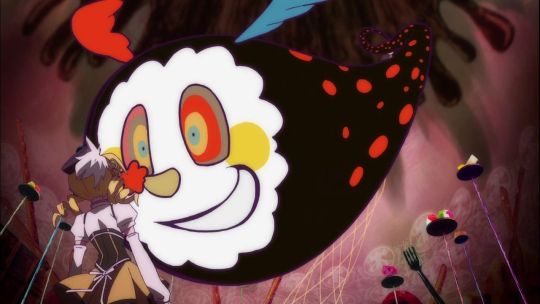
So what happens when a writer like this tackles a genre known for being all about hope, courage, and the power of friendship and love? There are many people who argue that Madoka Magica deconstructs the Magical Girl anime (Magical Girl Warrior subgenre) as codified by Sailor Moon or Cardcaptor Sakura. Some even say it’s the Neon Genesis Evangelion of the Magical Girl genre. As NGE showed us just how psychologically messed up a Giant Robot show would be if populated by actual human beings, Madoka Magica is about how having child combatants fight monsters in an urban environment with no support network does not make a well-adjusted childhood.
The effects of this kind of pressure and isolation on a bunch of adolescents is one of the elements of Madoka Magica, but fighting monsters with magic isn’t the only thing that makes a Magical Girl story. They’re traditionally as much coming-of-age stories as they are stories about definitions of femininity and self-determination. Madoka Magica has the trappings of a MG show: an all-loving protagonist, a dark and aloof rival, a tomboy friend, a non-magical friend, transformation sequences, fighting against the manifestations of dark emotions, and a cute(?) mascot. It’s talking the talk, but at its heart this is not a story about Magical Girl stories in the same way NGE was about Giant Robot anime (that’s what Revolutionary Girl Utena is for). It certainly plays with many common elements of the Magical Girl anime, but at its heart Madoka Magica is about hope, despair, idealism and selfishness. It’s a psychological drama and grand tragedy. It just happens to be wearing a Magical Girl outfit.

Which is not to say that one is superior to the other, of course. Just set your expectations accordingly if you’re already a Magical Girl fan. If you’re not, well, you might be in luck...
Twelve episodes isn’t a whole lot of time and Madoka Magica does a lot in those twelve episodes, so while I’m willing to spoil the tone of the story discussing the plot itself is a bit trickier. Kaname Madoka is our pink-haired milquetoast protagonist who doesn’t think she’s anything special, and just wants to make friends with everyone. We’re introduced to her via dream sequence, where she witnesses a dark-haired girl fighting against an enemy ravaging the city. A strange white bunny-cat creature asks Madoka to make a contract and become a magical girl, and then she wakes up. It turns out that when not dreaming of plot foreshadowing, Madoka has a pretty good life; a cool mom, a loving dad and good friends. But today it turns out the new transfer student at school - Akemi Homura - is the same girl from her dream. Homura warns Madoka to never change, to stay exactly as she is if she doesn’t want to lose her friends, family, everything she has ever loved. We wouldn’t have much of a story if Madoka never changed, though, so it isn’t long before the bunny-cat creature from the dream crashes into the narrative as well and introduces himself as Kyubey.
Kyubey offers Madoka and her best friend Sayaka an opportunity: make a contract with him and he will grant a single wish, any wish. In return the wisher receives magic powers and must now fight Witches. Not the pointed-hat, broomstick-riding variety, but rather strange, eldritch beings which bring about despair, death and suicide among ordinary humans. It sounds like a good deal: get magic powers and a superhero job on top of a wish? Who wouldn’t want that? But the catch is that this job is for life. If you’re spending all your free time saving the world, you’re not spending time with friends, getting a boyfriend, even just having fun. Is your wish worth dedicating your life to?
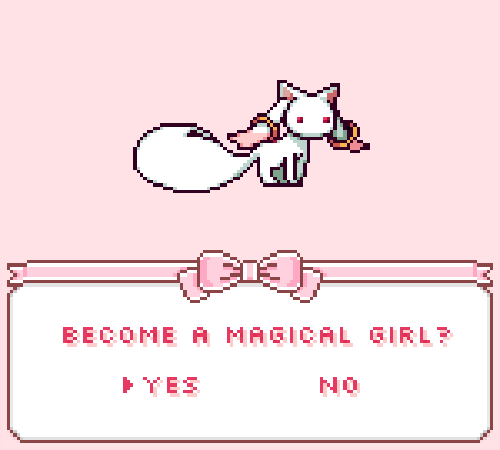
This story has a lot to say about good intentions. Our characters are living pretty good lives, so is there really anything worth giving that up for? Perhaps the wish is better spent on someone who needs it. But, remember, make a wish and you’re essentially fighting on behalf of that wish for the rest of your life. Is what you wish for really what you want, or do you really want some other outcome? Say you wish for a dying friend to heal; do you actually want them healed, or do you really want their eternal gratitude? All the characters in this story have the best intentions, but there’s a gap between intention and execution. If you don’t know what you really want, all the idealism in the world isn’t going to save you from your own regrets.
The phrase “I just wanted what was best” is a damning one. It's key to remember that the characters are adolescent girls, with all the contradictory vulnerability and immovable self-righteousness which comes at that age. It's the age at which ideas of how the world should be collide rudely with how the world actually is, and a person can either deal with it by changing themselves and developing coping mechanisms - healthy or unhealthy - or else break themselves on the impossibility of making their ideals fit with the system. Then again, it might be possible to change the system itself... but that’s a long shot.
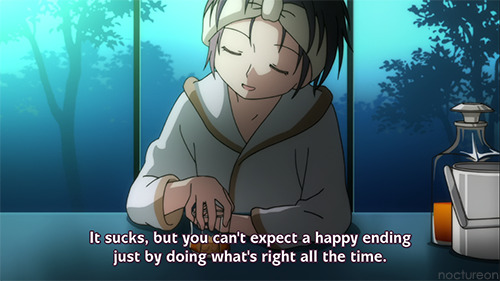
At one point Madoka’s mother gives her a piece of advice: if you see your friend hurting themselves while trying to to the right thing, maybe the best thing to do is to do the wrong thing for them to break them out of their self-destructive cycle. After all, they’re all still young, they’re at an age where recovering from mistakes is supposed to be easier than when you’re an adult. But this advice happens to come at the wrong time, because these kids are stuck in a situation where a mistake can cost one’s life.
As it happens the relationship between Madoka and her mother is one of the highlights in the series. Mom is a career-chasing businesswoman who still takes the time to talk to her daughter, and though she may not be working her dream job she’s living life on her own terms and is obviously an inspiration for Madoka. Her relationship with Madoka plays a surprisingly important role in the story, which is a refreshing change since parents are usually a non-factor or killed off for backstory purposes. The rest of the characters fit much more neatly into standard archetypes. Madoka herself has a big heart and wants everyone to get along, while her much more outgoing friend Sayaka is the go-getter who will take on problems head-first. We’re introduced early on to a much more experienced magical girl named Tomoe Mami, and she ends up taking a sort of big sister mentor role. All three of these girls believe in helping and protecting others, though each has their own take on the best way of doing so. Homura on the other hand is the dark and mysterious loner who for some reason is fixated on Madoka. We feel like she’s an antagonist, but another character who enters the story later turns out to be even more hostile. The red to Sayaka’s idealistic blue, this new magical girl feels like the antithesis to the magical girl ideals we’re used to: selfish, violent and hedonistic.

As elemental as each of these characters is, by the end of the story each one ends up in a very different place than where they started - or else had their starting position shifted altogether. Not everyone is what they seem. Homura’s backstory in particular hits like a truck when it finally arrives and ends up being key to the resolution of the plot. That said, Madoka Magica is not a story that goes in for particularly complex characterization. Its twelve-episode runtime forces a fast buildup and resolution. Friendships and other relationships don’t really have the time to mature on screen, and a lot has to be left to subtext or inference. Each character’s arc takes them where they need to go for the story to progress, and it’s not necessarily a bad thing. Some of these character arcs are desperately tragic tales of misunderstandings and misplaced idealism, but in the end these are still archetypal characters, though perhaps not the archetype you expected. Ultimately, they serve more as conflicting views on the show’s central themes than as the driving force of the story itself. The short length of the show is a weakness, keeping the story from being able to develop the cast as much as would have been ideal.
On the other hand, the show’s compact twelve episode structure is also its strength, and the ‘realism’ of the characters is much less important than what each one represents in the story as a whole. It’s hard to say whether or not Puella Magi Madoka Magica would’ve been able to hit as hard as it does if was any longer. This is a story very much focused on building its plot and keeping a steady pace, layering the tone and atmosphere and absolutely killing it in the aesthetics department. It is a straightforward story when all’s said and done, but it is densely constructed and cohesive. Every element of the show works as part of a whole and builds on the others, the visuals, the cinematography, the music, and even in the way the plot is structured. It’s got no time for cheap fanservice, it makes full use of every moment, and it only gets better on repeat viewings. This isn’t a show that supports casual viewing, and it expects you to be paying as much attention to the way a character is being framed in a shot as to what’s being said (or not said) in the dialogue. This is ultimately a simple story, yes, but it’s dense and constantly being told on multiple layers.

Puella Magi Madoka Magica’s ace in the hole is its mixed-media action scenes. Whenever our characters are fighting a Witch the show pulls a Terry Gilliam and starts doing very strange things with the animation. The medium of the art itself changes, with our cel-animated characters fighting against and among stop-motion objects. Paper cutouts and cotton balls. Lace and embroidery. The effect is unnerving and psychedelic and sometimes overwhelming. It can be difficult to follow the action whenever this happens, but then again these are supposed to be things that aren’t quite in sync with reality, beings which practically run on magic. The fact that these unreal things and spaces are being represented with real-world objects intruding into the animation is a clever touch. It’s an effect that I’ve rarely seen used in anime, and never in an action-heavy context.
(Author’s addendum: I’m aware that director Akiyuki Shinbo’s thing is this mix of visual styles. I do think its usage in Madoka Magica is still notable, if only because it works really well here.)
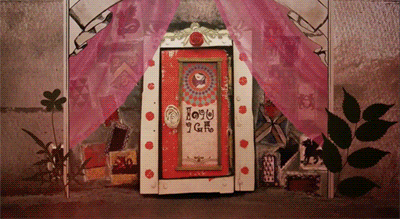
Even when it’s being more conventional Madoka Magica is visually accomplished. Even though the wide-faced character designs threw me for a loop at first (so wide!) they did eventually grow on me. There’s something about how the eyes look almost penciled-in which keeps them from straying into overly-cutesy territory. The cinematography is likewise superb. Strong, stylized color work drives home tone and emotion. The setting often dwarfs people within vast, empty cityscapes, the background itself being a reflection of the characters’ emotions and the series’ tone. In dialogue-heavy scenes we get momentary flashes of expression and action illustrating what’s happening inside a character’s head, and the framing of characters in a scene tells you everything you need to know about their relationships without saying a word. Whatever else you might think about Madoka Magica, it looks beautiful and tells much of its story visually through color, framing, light and shadow.
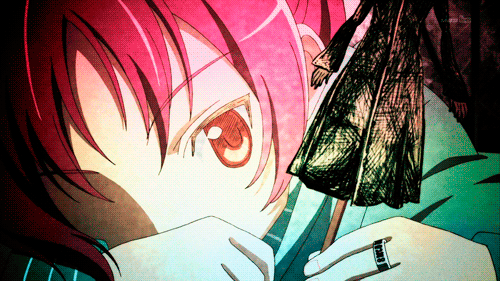
Going further than that, the structure of the plot is beautifully constructed as well. You could divide the story into four arcs of three episodes, each following the development of a different character, or else three arcs of four episodes, each one ending with a new point of no return. The third and tenth episodes mirror each other as well, each one shifting the stakes and giving us new context for everything which came before. The reason why this show shines so much brighter on a rewatch is because things that seemed like inconsequential melodrama or lazy writing the first time around take on a whole new meaning once backstory and motivation are revealed. It’s for this reason that I’m not terribly concerned about revealing Puella Magi Madoka Magica’s swerve into darkness; high stakes and dark subject matter are not the only secrets that this series has got up its sleeve. By the end of the story we’re not only dissecting the intentions and desires of our characters, we’re asking hard questions about why this story had to happen the way it did at all, questions which lead to what might be one of the most satisfying conclusions to an anime I’ve ever seen.
That is perhaps what makes Madoka Magica the show that it is. Though the ultimate shape of the story is straightforward, we journey there through layers of twisting color and twisting plot. Though we have our perspective on the events of the story constantly re-contextualized about once an episode, it’s always building to a conclusion that both feels inevitable and yet less likely the closer we get. And when the end does arrive, it takes everything that has happened so far, every mistake, every hope, every good intention gone wrong and it makes them matter. Though the ending is theoretically open ended, it’s entirely self-contained. It has introduced us to a new world, revealed the lies underlying this world, and has shown us what these characters do about it. It raises questions, and in the end tells us what it’s been saying all along. Few shows, anime or otherwise, use such a cohesive combination of visuals, narrative, and music to deliver a message. Beautiful to look at, beautiful to listen to, and beautiful in how it unfolds.
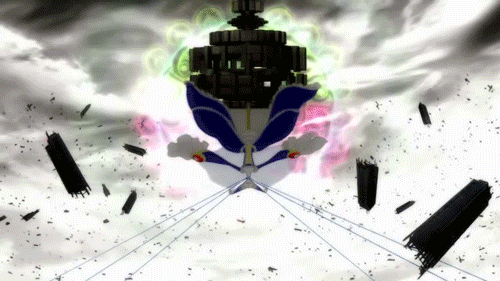
As it turned out, a sequel movie was made anyways. I refuse to provide any comprehensive thoughts on Puella Magi Madoka Magica: Rebellion for now, because doing so runs the risk of being flayed alive by the fandom no matter your take. Suffice it to say that it’s incredibly self-indulgent, visually stunning, and it will make you regret wishing that the ending of the original series could have been happier.
Puella Magi Madoka Magica is beautiful, and you really should watch it.
- Taihus, the wish-granting @raincoastgamer
(And I somehow manage to write all of this without actually discussing the soundtrack. The thing is, I don’t really know how to critique a soundtrack. It’s good, its use of leitmotifs is masterful and actually brought me to tears in episode 8, Magia represents the show’s true face behind the pleasant pink facade, and I’ve still got Sis Puella Magica stuck in my head.)
#puella magi madoka magica#pmmm#madoka magica#review#ramble#anime#anime ramble#anime article#anime review#I wrote a thing#gen urobuchi#akiyuki shinbo#studio shaft#aniplex#ume aoki#yuki kajiura
80 notes
·
View notes
Text
Alright, let me explain to you all exactly why Yuri on Ice didn’t deserve Best Animation.
Thunderbolt Fantasy’s crazy wuxia throwback literally made me fall in love with Asian puppet theater. I used to only associate puppetry with the Muppets and Sesame Street, and when we started learning about puppetry briefly in animation school, I just brushed it aside because I just wasn’t interested. I thought, “puppetry isn’t even as intricate and difficult as stop motion. Why should I have to learn about this?”
Then I saw Thunderbolt Fantasy and I was blown away. The fight scenes were phenomenal, puppet body parts flew everywhere, explosions kept happening. I would scream every week I saw a new episode. I never knew puppets could be used to tell stories like these before (and if it was obvious, it’s because I never paid attention). I went into the show for the Urobuchi writing, I came out a changed person.
The effort and intricacy behind these types of puppet shows are insane. Like, I can’t even imagine how much you have to practice all those puppet movements without breaking the doll (and trust me, I saw the dolls they used on display at Anime Expo, they looked pretty damn expensive). The characters are so beautifully crafted and they look amazing moving around on screen. I know that it takes a lot of training just to make dialogue acting believable, but how much do you have to train to coordinate fight sequences? And did you see the behind-the-scenes episode 0 doc? Those are actual explosives being used for special effects! Not for a big live action movie, but for a puppet show!
It’s already tough to sell stop motion to people who aren’t into animation as it is; I can’t imagine how hard it is to sell non-Muppet based puppets. I used to hear people say that they can’t stand stop motion because of how unnatural it is to see all this acting coming out of a doll. But how much different is that from regular animation? With regular animation, you are seeing acting coming out of paper or computer rendering. The beauty of animation is from seeing life coming out of lifeless things, and that kind of makes both puppets and stop motion technically the purest form of animation at its core. With how the character faces were molded in Thunderbolt Fantasy, it is next to impossible to read their feelings just by looking at them, which makes the show so narmy and uncanny to some. But when you see the character acting and movement put in, you get more feeling from their subtle gestures than you ever could from staring at a face. I felt fear, joy, excitement, sadness, and everything you would expect from any other art form while watching these puppets week to week. There is so much love and effort put into this show, that I feel it deserves as much recognition it can get.
There are too many people out there whining and saying “THEY’RE FUCKING PUPPETS. THIS ISN’T ANIME AT ALL!” And to all those people, fuck you, puppety is an important part of animation’s origins. It is just as “anime” as a Japanese produced flash cartoon. I was always curious about the side of Japanese animation that isn’t based around the same old 2D and CGI stuff they put out every year, but it always feels so closeminded in both the fans and the industry. I have seen people who don’t consider Japanese produced CGI video game cutscenes as anime and I’m like, ??????? Do you even consider them as animation in general? I remember a few years ago, Anime News Network put out an article on this pastel goth horror Alice in Wonderland stop motion film that was being released. I was so excited because I have never seen a full length stop motion Japanese feature before and I was so adamant at labeling it as “anime” right off the bat because, dammit, stop motion is animation and it was animated in Japan, it is an anime! Unsurprisingly, NO ONE GAVE A SHIT ABOUT IT. I probably have to lose an arm and a leg just to find anyone WILLING to fansub it if I paid them to. What makes that Alice film and Thunderbolt Fantasy so easily ostracized from the rest of the community is exposure and if projects like those get more success, we should be able to see more like them, and maybe then people will finally pull their ignorant asses off the ground and call them anime.
And don’t even get me started on the whole “IT’S NOT ANIMATED IN JAPAN” shit. Because guess what? No one is complaining that we’re calling To Be Hero an anime and the majority of that show was animated by popular Chinese web animators. In fact, the same goes to a large number of these Chinese co-pros involving heavy studio collaboration. So what if the puppetry was done in Taiwan? This show would not even exist without Urobuchi’s insistence. He was so determined to get this show off the ground and we’re lucky it was Urobuchi who came up with Thunderbolt Fantasy or else we never would’ve seen it past the starting line. The Japanese TV networks advertised this like crazy as Urobuchi’s big new project, and if you don’t consider an animated work with Gen fucking Urobuchi’s name hammered on to every open angle as an anime, I don’t know what to tell you.
I’m frustrated yet not surprised at all that Thunderbolt Fantasy was omitted from the Anime Awards. Thunderbolt Fantasy deserves so much more. It deserved some kind of recognition at least! You will not see a puppet show as fun, exciting, or well animated as this one (and if there is, sorry again! I’m really new to the scene). Thunderbolt Fantasy was one of the best action anime of the year, and barely anyone even knows it exists, and that is a crime! By the time season 2 rolls out, I better see more people hyping it up and I hope Crunchyroll will try harder to promote it. Everyone should check this show out at least once.
4 notes
·
View notes